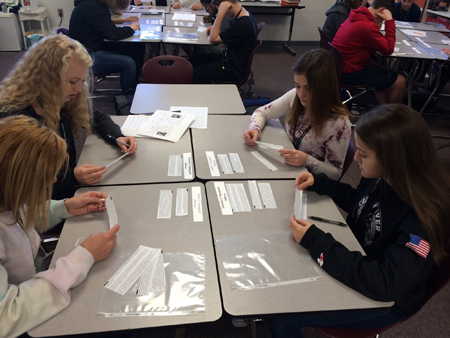Teaching Now: Using Primary Sources with 21st-Century Learners
This is a guest post from veteran teacher Heather Klos, an 8th grade U.S. history teacher and the Social Studies department chair at Crownover Middle School in Corinth, Texas.
As an early American history teacher, I know it is important to use primary sources effectively with my 8th grade students. Analyzing primary sources can be very difficult for students, but it is usually my end-game when working with these documents. I have found that breaking down the documents into manageable chunks and using some lower level skills from Bloom’s Taxonomy can be a useful starting point for students.
When we discuss the Civil War, two documents I always use with my students are the first inaugural addresses of Abraham Lincoln and Jefferson Davis. The speeches in their entirety can be overwhelming for students, especially when I have specific objectives I want the students to master using these primary sources
Analyze and compare how the speeches of Abraham Lincoln and Jefferson Davis talked about liberty, equality, union, and government.
Explain how Lincoln and Davis interpretation of the Constitution impacted their views on states’ rights
Before class, I pre-select five excerpts from each of the inaugural addresses for students to compare and contrast. I create 10 excerpt slips, cut the strips and place them into an envelope.
When the students arrive in class, we begin by defining and discussing words that they will find within the excerpts; words I know they may struggle with during their reading such as providence, assailed, apprehension, and unanimity. The words to be defined are emphasized in bold font within the excerpt strips.
Next, students are divided into partners and each pair is given an envelope. Students are instructed to read through each excerpt slip and group them based on whether they believe it is from Lincoln’s first inaugural address or from Davis’s inaugural address. By having the students read through and identify which man’s view is reflected within each excerpt they are using reasoning and analysis skills. I find it useful to travel around the room to individually ask students to explain the reasoning behind their groupings.
Once students have correctly sorted the 10 excerpts between the two speeches, students are asked to compare and contrast the views of Lincoln and Davis on the issues of liberty, equality, union, government and states’ rights. Students must provide textual evidence found within the selected excerpts.
The last part of the lesson involves students using Recap, a video response tool to analyze one of the excerpts of their choice.
Our 21st-century learners live in a world where information is delivered instantly, in short segments, usually with a hashtag and can become overwhelmed when tasked with analyzing an entire speech written 200+ years earlier. But primary source lessons using original texts do not have to be difficult for teachers to prepare or students to comprehend. Making these documents easily accessible by chunking them into smaller sections allow teachers to guide the students in the direction of the learning objectives. I have seen students’ analysis skills deepen as well as their confidence in their ability to use primary sources.
This lesson can be easily adapted. In fact, I have used this same lesson with excerpts from the Federalist Papers and texts written by anti-federalists.
Don’t miss Heather’s other post, Integrating Tech: Let’s Recap & Primary Source Analysis.

